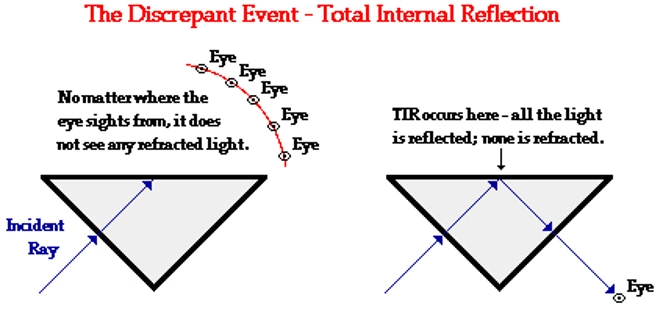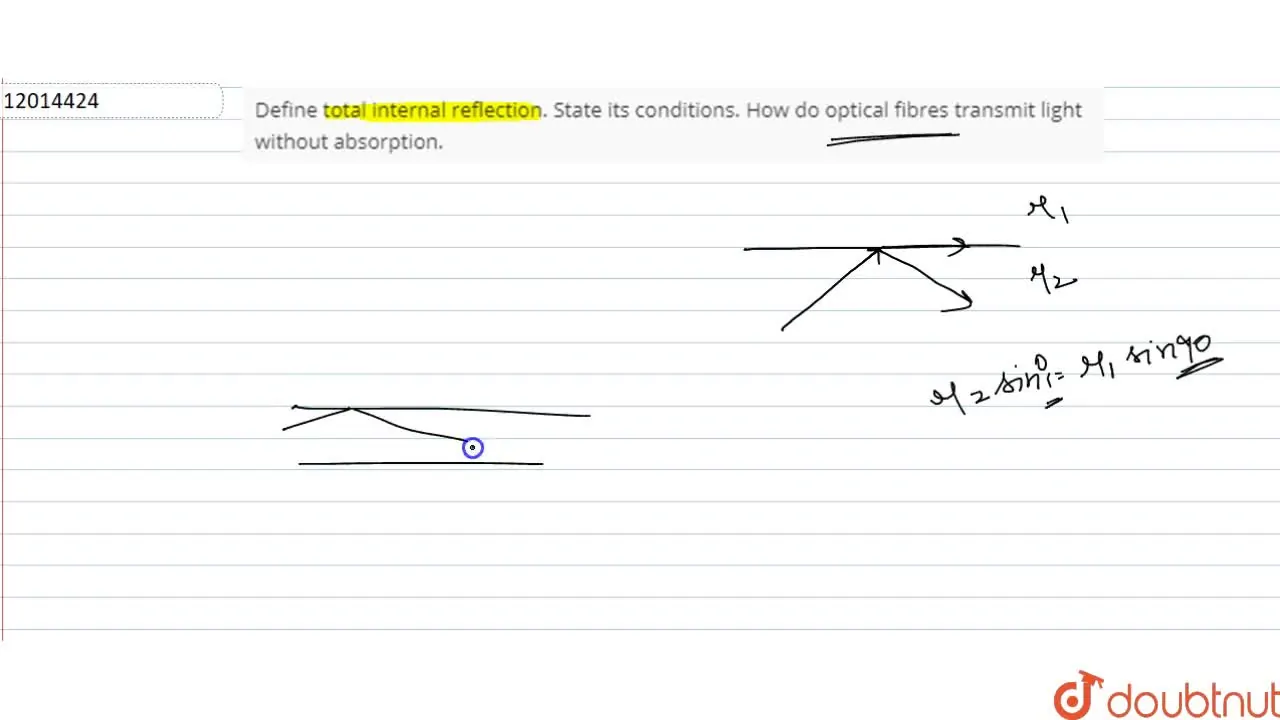Define total internal reflection. State its conditions. How do optical fibres transmit light without absorption.
Total Internal Reflection
A typical Physics lab is to locate through the long side of an isosceles triangle at a pin or other article held behind the contrary face. At the point when done as such, an unordinary perception - a discrepant occasion - is watched. The outline on the left beneath portrays the physical circumstance.
A ray of light entered the essence of the triangular square at a correct edge to the limit. This ray of light goes over the limit without refraction since it was occurrence along the typical. The ray of light at that point goes in a straight line through the glass until it arrives at the subsequent limit.
Presently as opposed to transmitting over this limit, the entirety of the light appears to reflect off the limit and transmit out the contrary substance of the isosceles triangle. This discrepant occasion disturbs numerous as they go through a few minutes searching for the light to refract during that time limit.
At that point at last, shockingly, they glanced through the third essence of the square and unmistakably observe the ray. What happened? Why did light not refract through the second face?

The phenomenon observed in this part of the lab is known as total internal reflection. Total internal reflection, or TIR as it is intimately called, is the reflection of the total amount of incident light at the boundary between two media. TIR is the theme of center in Lesson 3.
To comprehend total internal reflection, we will start with a psychological test. Assume that a laser ray is submerged in a tank of water (don't do this at home) and pointed upwards towards water-air limit. At that point guess that the edge at which the ray is coordinated upwards is gradually modified, starting with little edges of occurrence and continuing towards bigger and bigger edges of rate. What might be seen in such an investigation? On the off chance that we comprehend the standards of limit conduct, we would expect that we would watch both reflection and refraction. What's more, in reality, that is what is watched (for the most part). Yet, that is by all account not the only perception that we could make.
We would likewise see that the force of the reflected and refracted rays doesn’t stay consistent. At edge of rate near 0 degrees, the greater part of the light vitality is transmitted over the limit and next to no of it is reflected. As the edge is expanded to more prominent and more noteworthy edges, we would start to watch not so much refraction but rather more reflection.
That is, as the point of rate is expanded, the splendor of the refracted ray diminishes and the brilliance of the reflected ray increments. At long last, we would see that the points of the reflection and refraction are not rise to.
Since the light waves would refract away from the ordinary (an instance of the SFA rule of refraction), the point of refraction would be more prominent than the edge of rate. What's more, if this was the situation, the edge of refraction would likewise be more noteworthy than the edge of reflection (since the edges of reflection and occurrence are the equivalent).
As the angle of occurrence is expanded, the angle of refraction would inevitably arrive at a 90-degree angle. These principles are depicted in the diagram below.

The maximum possible angle of refraction is 90-degrees. Looking at this logically (a training that consistently causes), you perceive that on the off chance that the point of refraction were more prominent than 90 degrees, at that point the refracted beam would lie on the occurrence side of the medium - that is simply impractical.
So on account of the laser beam in the water, there is some particular incentive for the point of rate (we'll consider it the basic edge) that yields an edge of refraction of 90-degrees. This specific incentive for the point of occurrence could be determined utilizing Snell's Law (ni = 1.33, nr = 1.000, = 90 degrees, = ???) and would be seen as 48.6 degrees.
Any edge of frequency that is more prominent than 48.6 degrees would not bring about refraction. Rather, when the edges of frequency is more prominent than 48.6 degrees (the basic edge), the entirety of the vitality (the complete vitality) conveyed by the episode wave to the limit remains inside the water (inward to the first medium) and experiences reflection off the limit. At the point when this occurs, all out inner reflection happens.
Two Requirements for Total Internal Reflection
Total interior reflection (TIR) is the wonder that includes the impression of all the occurrence light off the limit. TIR possibly happens when both of the accompanying two conditions are met:
- the light is in the denser medium and moving toward the less dense medium.
- the angle of incidence is greater than the so-called critical angle.
Total internal reflection won't occur except if the occurrence light is going inside the more optically thick medium towards the less optically thick medium. TIR will occur for light going from water towards air, however it won't occur for light going from air towards water. TIR would occur for light going from water towards air, yet it won't occur for light going from water (n=1.333) towards crown glass (n=1.52). TIR happens in light of the fact that the point of refraction arrives at a 90-degree edge before the edge of rate arrives at a 90-degree edge.
The main route for the point of refraction to be more noteworthy than the edge of frequency is for light to twist away from the typical. Since light possibly twists from the ordinary when going from an increasingly thick medium into a less thick medium, at that point this would be an important condition for total internal reflection. Total internal reflection only occurs with large angles of incidence.


Related Playlists
- BOOK - PRADEEPCHAPTER - OPTICSEXERCISE - Very short answer question5videos
OPTICS
- BOOK - PRADEEPCHAPTER - OPTICSEXERCISE - very short answer questions1videos
OPTICS
- BOOK - PRADEEPCHAPTER - MAGNETIC EFFECT OF CURRENT AND MAGNETISMEXERCISE - Competition Focus (Multiple Choice Questions)2videos
MAGNETIC EFFECT OF CURRENT AND MAGNETISM
Similar Questions
Define total internal reflection of light.
View SolutionDefine total internal reflection of light.
View Solution" For total internal reflection of light condition is "
View SolutionIn total internal reflection, the light travels from
View SolutionWhat is total internal reflection of light ? What are conditions for total internal reflection ?
View SolutionFor total internal reflection, light must travel
View SolutionTotal internal reflection(T.I.R.)||Examples on T.I.R.||Optical fibre
View SolutionWhat is total internal reflection ? Under what conditions it takes place ?
View SolutionTotal internal reflection can occur when light tends to pass from
View SolutionWhat is total internal reflection of light ? What are conditions for total internal reflection ?
View Solution


